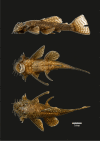Whole genome assembly of the armored loricariid catfish Ancistrus triradiatus highlights herbivory signatures
- PMID: 36006456
- PMCID: PMC9596584
- DOI: 10.1007/s00438-022-01947-6
Whole genome assembly of the armored loricariid catfish Ancistrus triradiatus highlights herbivory signatures
Abstract
The catfish Ancistrus triradiatus belongs to the species-rich family Loricariidae. Loricariids display remarkable traits such as herbivory, a benthic lifestyle, the absence of scales but the presence of dermal bony plates. They are exported as ornamental fish worldwide, with escaped fishes becoming a threat locally. Although genetic and phylogenetic studies are continuously increasing and developmental genetic investigations are underway, no genome assembly has been formally proposed for Loricariidae yet. We report a high-quality genome assembly of Ancistrus triradiatus using long and short reads, and a newly assembled transcriptome. The genome assembly is composed of 9530 scaffolds, including 85.6% of ray-finned fish BUSCOs, and 26,885 predicted protein-coding genes. The genomic GC content is higher than in other catfishes, reflecting the higher metabolism associated with herbivory. The examination of the SCPP gene family indicates that the genes presumably triggering scale loss when absent, are present in the scaleless A. triradiatus, questioning their explanatory role. The analysis of the opsin gene repertoire revealed that gene losses associated to the nocturnal lifestyle of catfishes were not entirely found in A. triradiatus, as the UV-sensitive opsin 5 is present. Finally, most gene family expansions were related to immunity except the gamma crystallin gene family which controls pupil shape and sub-aquatic vision. Thus, the genome of A. triradiatus reveals that fish herbivory may be related to the photic zone habitat, conditions metabolism, photoreception and visual functions. This genome is the first for the catfish suborder Loricarioidei and will serve as backbone for future genetic, developmental and conservation studies.
Keywords: Freshwater; Genomics; Herbivory; Loricariidae; Loricarioidei; Vision.
© 2022. The Author(s).
Conflict of interest statement
The authors declare that they have no conflict of interest.
Figures



Similar articles
-
Phylogenomic reappraisal of the Neotropical catfish family Loricariidae (Teleostei: Siluriformes) using ultraconserved elements.Mol Phylogenet Evol. 2019 Jun;135:148-165. doi: 10.1016/j.ympev.2019.02.017. Epub 2019 Feb 22. Mol Phylogenet Evol. 2019. PMID: 30802595
-
Development of the chondrocranium in the suckermouth armored catfish Ancistrus cf. triradiatus (Loricariidae, Siluriformes).J Morphol. 2005 Dec;266(3):331-55. doi: 10.1002/jmor.10381. J Morphol. 2005. PMID: 16235249
-
Development of the osteocranium in the suckermouth armored catfish Ancistrus cf. triradiatus (Loricariidae, siluriformes).J Morphol. 2007 Mar;268(3):254-74. doi: 10.1002/jmor.10515. J Morphol. 2007. PMID: 17299777
-
Chromosome-level assembly of southern catfish (silurus meridionalis) provides insights into visual adaptation to nocturnal and benthic lifestyles.Mol Ecol Resour. 2021 Jul;21(5):1575-1592. doi: 10.1111/1755-0998.13338. Epub 2021 May 12. Mol Ecol Resour. 2021. PMID: 33503304
-
Nutrient recycling by two phosphorus-rich grazing catfish: the potential for phosphorus-limitation of fish growth.Oecologia. 2005 Dec;146(2):247-57. doi: 10.1007/s00442-005-0202-5. Epub 2005 Oct 28. Oecologia. 2005. PMID: 16133197
Cited by
-
The Sensory Shark: High-quality Morphological, Genomic and Transcriptomic Data for the Small-spotted Catshark Scyliorhinus Canicula Reveal the Molecular Bases of Sensory Organ Evolution in Jawed Vertebrates.Mol Biol Evol. 2024 Dec 6;41(12):msae246. doi: 10.1093/molbev/msae246. Mol Biol Evol. 2024. PMID: 39657112 Free PMC article.
-
Chromosome-level genome assembly of the largefin longbarbel catfish (Hemibagrus macropterus).Front Genet. 2023 Nov 1;14:1297119. doi: 10.3389/fgene.2023.1297119. eCollection 2023. Front Genet. 2023. PMID: 38028621 Free PMC article.
References
-
- Bail PL, Covain R, Jégu M, et al. Updated checklist of the freshwater and estuarine fishes of French Guiana by. Cybium. 2012;36:293–319.
-
- Benedito-Cecilio E, Araujo-lima CAR, Forsberg B, et al. Carbon sources of Amazonian fisheries. Fish Manag Ecol. 2000;7:305–315. doi: 10.1046/j.1365-2400.2000.007004305.x. - DOI
MeSH terms
Substances
Grants and funding
LinkOut - more resources
Full Text Sources
Miscellaneous

